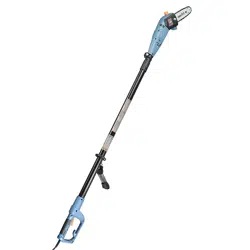Loading ...
Loading ...
Loading ...

5WWW.SENIXTOOLS.COM
• Damage to lungs if an effective dust mask is not worn.
• Damage to hearing if effective hearing protection is
not worn.
• Health defects resulting from vibration emission if the
unit is being used over long periods of time or not
adequately managed and properly maintained.
RESIDUAL RISKS
CAUTION:
WARNING:
WARNING:
WARNING:
WARNING:
WARNING:
resulting in a loss of power and overheating of tool.
For this tool an AWG (American Wire Gauge) size of
a least 14-gauge is recommended for an extension
cord of 25-ft. or less in length. Use 12-gauge for an
extension cord of 50-ft. Extension cords 100-ft. or
longer are not recommended. Remember, a smaller
wire gauge size has greater capacity than a larger
number (14-gauge wire has more capacity than
16-gauge wire; 12-gauge wire has more capacity than
14-gauge). When in doubt use the smaller number.
Minimum gauge for extension cords
Ampere Rating
Volts Total length of cord in feet
More than/Not more than AWG
120 V 25 50 100 150
0-6
6-10
10-12
18
18
16
16
16
16
16
14
14
14
12
12
12-16 14 12 Not recommended
Securing extension cord
Keep the extension cord clear of the work area. Position
the cord so that it will not get caught on bushes,
hedges, tree trunks, lawnmowers or other obstructions
while you are working with the pole saw.
Check extension cords before each use. If damaged
replace immediately. Never use tool with a damaged
cord since touching the damaged area could cause
electrical shock, resulting in serious injury.
Even when the unit is used as prescribed it is not
possible to eliminate all residual risk factors. The
following hazards may arise in connection with the unit’s
construction and design:
This unit produces an electromagnetic eld during
Inspect unit before each use. Replace damaged parts.
Make sure all fasteners are in place and secure.
Replace parts that are cracked, chipped, or damaged in
any way. Make sure the cutting attachment is properly
installed and securely fastened.
Do not operate the unit inside a closed environment,
such as a room or building.
operation. This eld may, under some circumstances,
interfere with active or passive medical implants. To
reduce the risk of serious or fatal injury, we recommend
persons with medical implants to consult their physician
and the medical implant manufacturer before operating
this unit.
Kickback can occur when the tip of the guide bar
touches an object or when the wood closes in and
pinches the saw chain inside of the cut. Tip contact can
kick the guide bar up and back towards the operator.
Pinching the saw chain along the top of the guide bar
can push the bar rapidly towards the operator. Either of
these reactions may cause a loss in control of the saw,
increasing the chances of serious personal injury. Do
not rely on the safety devices built into the saw.
Kickback is the result of tool misuse and/or incorrect
operating procedures. These conditions can be
minimized with the following steps:
REDUCING KICKBACK
WARNING:
The danger of a kickback is greatest when attempting
to cut near or with the guide bar tip. Always apply the
saw as atly as possible in order avoid a loss of control
during operation.
1. Maintain a rm grip, with thumbs and ngers
encircling the pole saw handles. Both hands should
be on the saw with your body and arms in a position
to resist kickback forces.
2. Do not overreach and keep the work area free from
obstructions.
3. Only use replacement bars and chains specied by
Senix. Replace dull blades as necessary.
4. Do not let the tip of the guide bar contact any
surfaces.
5. Keep proper tension on the blade at all times. Check
the tension at regular intervals.
6. Cuts should only take place while the chain is moving
at full speed. Do not turn the saw ON or OFF in
the middle of a cut. Use extreme caution when re-
entering a previous cut.
7. Cut one branch at a time. Do not attempt plunge or
bore cuts. Watch for shifting logs or other external
forces that could close a cut and pinch the chain.
8. Make a precut on the opposite side of the log to
avoid the blade from being pinched during operation
as another safeguard against kickback.
Loading ...
Loading ...
Loading ...
